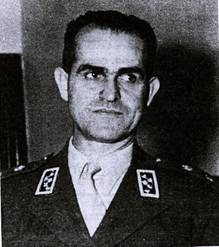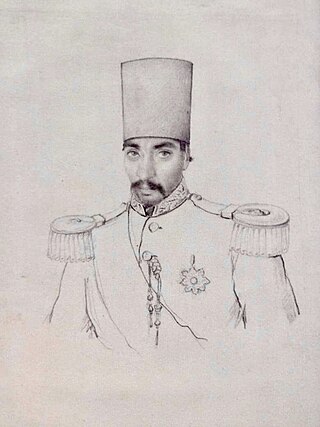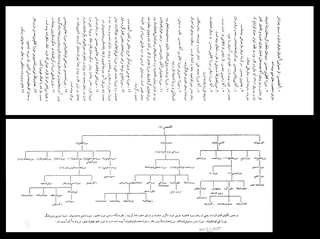
The Qajar dynasty was an Iranian royal dynasty founded by Mohammad Khan of the Qoyunlu clan of the Turkoman Qajar tribe.

Fath-Ali Shah Qajar was the second Shah of Qajar Iran. He reigned from 17 June 1797 until his death on 24 October 1834. His reign saw the irrevocable ceding of Iran's northern territories in the Caucasus, comprising what is nowadays Georgia, Dagestan, Azerbaijan, and Armenia, to the Russian Empire following the Russo-Persian Wars of 1804–1813 and 1826–1828 and the resulting treaties of Gulistan and Turkmenchay. These two treaties are closely tied to Fath-Ali Shah's legacy amongst Iranians, who often view him as a weak ruler.

Mozaffar ad-Din Shah Qajar (Persian: مظفرالدین شاه قاجار, romanized: Mozaffareddin Šāh-e Qājār; was the fifth Qajar shah of Iran, reigning from 1896 until his death in 1907. He is often credited with the creation of the Persian Constitution of 1906, which he approved of in one of his final acts as shah.

Naser al-Din Shah Qajar was the fourth Shah of Qajar Iran from 5 September 1848 to 1 May 1896 when he was assassinated. He was the son of Mohammad Shah Qajar and Malek Jahan Khanom and the third longest reigning monarch in Iranian history after Shapur II of the Sassanid dynasty and Tahmasp I of the Safavid dynasty. Naser al-Din Shah had sovereign power for close to 51 years.

Mohsen Sadr was a judge and politician, the prime minister of Iran and the president of the Senate of Iran. During his government, Iran became one of the founding states of the United Nations by signing the Charter of the United Nations.
Prince Soltan Ali Mirza Kadjar (Qajar) (Persian: سلطانعلی میرزا قاجار; November 16, 1929 – May 27, 2011) was an Iranian Prince of Qajar dynasty and the son of Soltan Majid Mirza Qajar (1907–1975) and Homadokht Kian (Shayesteh Khanoum) (1912–1992) and the grandson of Mohammad Ali Shah Qajar. He was the Head of the Qajar Imperial Family. Despite Soltan Ali Mirza Qajar being Head of the Qajar Imperial Family, the Qajar claimant to the Sun Throne was the Heir Presumptive Mohammad Hassan Mirza II, son of Soltan Hamid Mirza and grandson of Soltan Ahmad Shah's brother and successor in exile, Mohammad Hassan Mirza Qajar.

Kamran Mirza was a Qajar prince and third surviving son of Naser al-Din Shah Qajar. He was the brother of Mass'oud Mirza Zell-e Soltan and Mozaffar ad-Din Shah Qajar. Kamran Mirza also served as Iran's Commander-in-Chief, appointed in 1868 for the first time, and minister of war from 1880 to 1896 and from 1906 to 1907.

Mahmoud Afshartous, also written Afshartoos, was an Iranian general and chief of police during the government of Prime Minister Mohammad Mossadegh. Afshartous was abducted and killed by anti-Mossadegh conspirators led by MI6 which helped pave the way for the 1953 coup d'état.
Zarrinnaal or Zarrin Naal is the name of a dynasty of Kurdish tribal chiefs and state officials belonging to the Zarrin Kafsh tribe and originated from Sanandaj in Kurdistan Province of Iran. Their heads with the title of Beyg, Beyk or Beg (lit."lord") were the Aghas of Senneh and ruled their fiefdom during the time of four hundred years when the Safavids, Afsharids and finally Qajar dynasty reigned in Iran.

Malek Jahan Khanom was the wife of Mohammad Shah Qajar and the mother of Naser al-Din Shah. She was the de facto regent of Iran for one month, from 5 September until 5 October in 1848, between the death of her husband and the accession of her son.

Ali Akbar Bahman was an Iranian diplomat and politician during the Qajar and Pahlavi eras.

Amanollah Khan Zia' os-Soltan was an Iranian aristocrat and politician at Qajar court during the time of Mozaffar ad-Din Shah, Mohammad Ali Shah and Ahmad Shah Qajar and hero of the Persian Constitutional Revolution.

Mohammad Taqi Mirza Hessam os-Saltaneh was an Iranian Prince of the Qajar dynasty, son of Fath-Ali Shah. He was Governor-General (beglerbegi) of Kermanshah and of Boroujerd.

The House of Bahmani, also called Bahmani-Qajar, is an aristocratic Iranian family belonging to one of the princely families of the Qajar dynasty, the ruling house that reigned Iran 1785–1925. The founder is Bahman Mirza Qajar (1810–1884), the younger brother of Mohammad Shah Qajar and formerly prince regent and governor of Azerbaijan 1841–1848.

Prince Anoushiravan Mirza "Zia' od-Dowleh" "Amir Touman" (1833-1899) was an Iranian prince of the Qajar dynasty, politician, and governor.

Anoushirvan (Shir) Khan Qajar Qovanlou 'Eyn ol-Molk' 'Etezad od-Doleh' was an Iranian aristocrat, general and courtier.

Abbasqoli Khan Mo'tamed od-Dowleh Javanshir was an Iranian official from the Javanshir tribe, who served as the first Minister of Justice of Iran from 1858 to 1861.

Mostowfian Ashtiani family were a Persian family during the Zand period who came to power in the Qajar dynasty and retained power until the middle of the Pahlavi dynasty. Their family occupation was land ownership, but after in Qajar introduced the position of Mostowfi into the Iranian bureaucracy, the family began to work as Mustawfis and took their name from this title. Mostowfian Ashtiani became known as the Hezar Famil because of their influence and power in the Qajar bureaucracy.

Mirza Yusuf Ashtiani also known as Mostowfi ol-Mamalek was the Grand Vizier of Iran during the reign of Nasser al-Din Shah and one of the most influential members of Qajar bureaucratic system at that time. He was from the conservative faction of the Qajar court and an opponent of Mirza Hosein Khan Moshir od-Dowleh and his reforms.
Ziyadoghlu Qajar or Ziyadlu were a branch of the Qajar tribe that governed Safavid Karabakh from 1546–1554 to 1743, Astarabad in various times, Ganja Khanate from 1747 to 1805. Some authors suggested that, Qovanlu branch of Qajars who ruled Iran from 1789 to 1925, which is currently better known as Qajar dynasty was a cadet-branch of Ziyadoghlu family.















